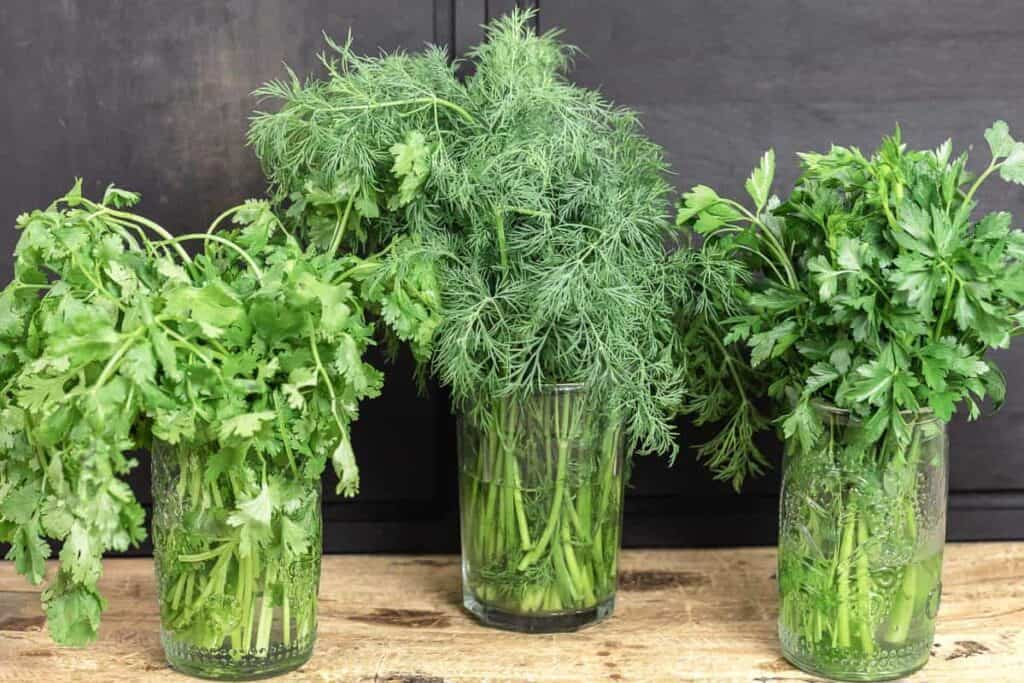SUMMARY: Comparing shelf lives between dry and fresh herbs reveals that proper storage methods can significantly extend their usability, with dry herbs generally offering a longer shelf life than their fresh counterparts.

Ever wondered why your herbs lose their flavor or spoil before you get the chance to use them?
Understanding the shelf life of herbs, both fresh and dried, can be the key to preserving their robust flavors and medicinal properties.
- What influences the shelf life of herbs?
- Best practices for storing dried herbs.
- Tips on keeping fresh herbs vibrant.
- Comparing the longevity of dry versus fresh herbs.
Continue reading to discover how you can maximize the use of your herbs through optimal preservation strategies.
Understanding Herb Shelf Life
Herb shelf life is a dynamic attribute influenced by several key factors that can either preserve their essence or hasten their decline. Moisture, light, and temperature stand out as the primary environmental aspects that directly impact the longevity of herbs. Dry herbs, in particular, are susceptible to moisture which can lead to mold growth and loss of flavor. On the other hand, fresh herbs require a certain level of humidity to maintain their vibrancy but can quickly perish if conditions are overly moist or too dry. Light can degrade the potent oils in herbs, diminishing their flavor and medicinal benefits, while temperatures that are too high can accelerate decay in fresh herbs and degrade the quality of dried ones. Understanding these factors is the first step towards mastering the art of preserving herbs to extend their shelf life as much as possible.
Dry Herbs: Preservation and Longevity
When it comes to dried herbs, the nuances of preservation are key to extending their shelf life. The process of drying herbs effectively removes the majority of their moisture content, which is a primary factor in the degradation of plant material. By reducing moisture, dried herbs become less hospitable to bacteria, mold, and yeast, all of which contribute to spoilage.
To achieve optimal longevity, dried herbs should be stored in airtight containers away from direct sunlight. Exposure to light can degrade the essential oils that give herbs their unique flavors and aromas. Similarly, fluctuations in temperature can affect the potency of dried herbs over time. A cool, dark, and dry environment is ideal for prolonging their shelf life.
Under these conditions, dried herbs can maintain their quality for 1 to 3 years. However, potency is highest in the first year and gradually diminishes. It’s important to note that while dried herbs do not spoil in the traditional sense, they do lose their flavor and potency, which is a critical consideration for culinary applications.
Fresh Herbs: Keeping Them Vibrant
Maintaining the freshness and vibrancy of herbs involves a different set of challenges compared to drying. Fresh herbs, with their high moisture content, are particularly susceptible to spoilage caused by molds and bacteria. Proper storage techniques are crucial to extend their shelf life as much as possible.
For most fresh herbs, refrigeration is the best method to retain freshness. They should be loosely wrapped in a damp paper towel and placed in a breathable bag before storing in the refrigerator. This method maintains the necessary humidity around the herbs without excess water encouraging decay. Some herbs, like basil, are sensitive to cold and are best stored at room temperature in a glass of water, much like a bouquet.
Even with the best care, the shelf life of fresh herbs is significantly shorter than their dried counterparts, typically lasting from a few days to two weeks. The exact lifespan depends on the type of herb and the conditions of storage.
Comparative Analysis: Dry Vs. Fresh
Comparing the shelf lives of dry and fresh herbs reveals distinct advantages and limitations for each. Dried herbs offer the convenience of longer storage times, making them a staple in pantries for regular use without the worry of quick spoilage. Their concentrated flavors are especially suited for dishes that cook for longer periods, where they have time to rehydrate and infuse the dish.
Fresh herbs, on the other hand, bring a vibrant and often delicate flavor profile that is unmatched by their dried counterparts. They are preferable in dishes where the freshness of the herb is paramount, such as in salads, garnishes, or added at the end of cooking to preserve their essence. The trade-off with fresh herbs is their short shelf life, which requires frequent purchasing or harvesting for the best culinary results.
Understanding these differences and how to best store each type of herb can greatly impact their effectiveness in culinary applications and reduce waste.
Optimal Storage Solutions for Herbs
The key to maximizing the shelf life of both dry and fresh herbs lies in understanding and implementing optimal storage solutions. For dried herbs, the priority is to avoid exposure to heat, light, and moisture. They should be stored in airtight containers placed in a cool, dark cupboard. This environment ensures that dried herbs can retain their flavor and potency for up to three years, although checking them annually for freshness is recommended.
Fresh herbs, on the other hand, require a slightly different approach to prolong their usability. Most fresh herbs benefit from being stored in the refrigerator, either loosely wrapped in a damp paper towel and placed in a plastic bag or standing upright in a glass of water, covered with a plastic bag. Some hardy herbs like rosemary, thyme, and sage can last up to two weeks when stored this way, while more delicate herbs such as cilantro and parsley may have a shorter fridge life.
Another notable method for extending the freshness of herbs involves freezing. This can be especially effective for fresh herbs, as it preserves their essential oils and maintains flavor for longer periods. Freezing herbs in ice cube trays with water or olive oil can provide convenient, flavor-packed portions ready to be added to dishes as needed.
In essence, proper storage significantly affects the shelf life and quality of both dry and fresh herbs. By utilizing these strategies, one can ensure that their herbs remain as vibrant and flavorful as possible, ready to enhance any culinary creation.
Visual Quality and Potency Check
Regularly assessing the visual quality and potency of herbs is crucial to effectively using them before they lose their prime. Dried herbs, while having a longer shelf life, can lose their color, aroma, and flavor over time. A simple visual and olfactory test can help determine their freshness: vibrant colors and a strong, distinct aroma suggest that the herbs are still potent. If the color has faded significantly or if the herbs smell musty, it’s likely time to replace them.
For fresh herbs, the signs of decline are more noticeable. Wilting, discolored, or slimy leaves are clear indicators that the herbs are past their best. To ensure the use of fresh herbs while they are still vibrant, inspect them often, especially if stored in the refrigerator, where they can deteriorate quickly if not properly maintained.
It’s also important to consider the potency of herbs when adding them to your dishes. As dried herbs are more concentrated than their fresh counterparts, a general rule of thumb is to use one-third the amount of dried herb when substituting for fresh. This ensures that the flavor is balanced and not overpowering, allowing the essential characteristics of the herb to enhance the dish without dominating it.
Conducting regular checks on the visual quality and potency of both dried and fresh herbs not only helps in maintaining a high standard for your culinary creations but also minimizes waste by ensuring that herbs are used within their optimal period of freshness.
Maximizing Shelf Life and Flavor
In summary, this guide offers a foundational comparison between the shelf lives of dried and fresh herbs, aiming to enhance culinary experiences while reducing waste.
- Moisture, light, and temperature significantly impact the shelf life of herbs, with different effects on fresh versus dried ones.
- Dried herbs, with proper preservation methods, can maintain their potency and flavor for an extended period, typically longer than their fresh counterparts.
- Fresh herbs require specific storage solutions to stay vibrant and flavorful, emphasizing the importance of moisture control and cool temperatures.
- A comparative analysis reveals that while both types of herbs have their benefits, understanding their unique storage needs is essential for maximizing their use in culinary arts.
Armed with the knowledge from this guide, enthusiasts and cooks alike can confidently navigate the nuances of herb preservation, ensuring that every dish benefits from the optimal flavor and aroma of these essential ingredients.
10 Best Ways to Compare Shelf Lives of Herbs FAQs
What are the key factors that affect the shelf life of herbs?
The key factors influencing the shelf life of herbs include moisture, light, and temperature. Fresh herbs are particularly sensitive to moisture and need to be stored properly to avoid spoilage, whereas dried herbs need protection from light and air to maintain their potency over time. Understanding and controlling these factors can significantly extend the usability of both fresh and dried herbs.
How long can you typically expect dried herbs to last?
Dried herbs, when stored correctly in a cool, dark place and in airtight containers, can last up to 1-3 years. The exact duration depends on the specific herb and storage conditions. Their shelf life is considerably longer compared to fresh herbs, making them a convenient and economical option for long-term culinary use.
Are there any special considerations for storing fresh herbs to extend their shelf life?
Yes, storing fresh herbs requires specific conditions to maximize their shelf life. They should be kept either in a refrigerator in loosely tied or unsealed bags that allow for air circulation, or in a cup of water at room temperature, depending on the herb. Some herbs may also benefit from being wrapped in a damp paper towel before refrigeration to maintain moisture without becoming soggy.
Can the flavor of herbs change over time, even if they are stored properly?
Yes, the flavor of herbs can change over time, even with proper storage. Dried herbs tend to lose their potency gradually, necessitating an increase in quantity used for cooking to achieve the desired flavor profile. Fresh herbs may also experience a degradation in flavor if not used within their optimal freshness window. Regular inspection and timely use are recommended to enjoy herbs at their best.
